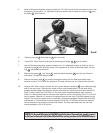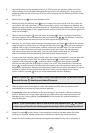
13
5.0 SECOND STAGE PROCEDURES
5.1 TOOLS REQUIRED FOR SECOND STAGE SERVICING
– Two good quality 6" or 8" (15 or 20 cm) adjustable wrenches
– #10 Torx screwdriver
– Side cutting pliers
– Sherwood In-line Adjusting Tool (p/n TL102)
– Sherwood Plastic Probe (p/n TL111) to push out orifice
– Sherwood Lever Height Adjusting Tool (p/n TL123)
5.2 DISASSEMBLY OF SECOND STAGE
To view the complete parts list of the second stage, fold out the back cover of this manual.
1. Remove the hose assembly from the orifice housing . Inspect the hose assembly for
any cuts or cracks, especially on the hose at the metal ferrules. Replace the hose assembly if
any cuts or cracks are found.
2. Remove the mouthpiece by cutting the mouthpiece tie with side cutting pliers. Discard
the old mouthpiece tie. Examine the condition of the mouthpiece. Pay particular attention to
the area on top just behind where the old tie tightened. This is a prime area for small holes to
develop. If the mouthpiece is in good condition, it can be reused.
3. Remove the exhaust tee retaining screws with a #10 Torx or slotted screwdriver.
4. Remove the exhaust tee from the case by pulling it back and off the top edge.
5. Remove the cover from the case by inserting the thumb nail under the edge opposite
the hose. Slide the cover assembly off of the orifice housing.
6. Remove the diaphragm retaining ring from the case using the fingers.
7. Gently remove the diaphragm from the case. Hold the diaphragm up to a light source.
Gently stretch the diaphragm and look for tears or pinholes. If any are found, replace the
diaphragm. Otherwise, the diaphragm can be reused. If you are repeatedly tearing diaphragms
during this visual inspection, you are using too much force. You cannot return diaphragms
torn in this way for warranty credit.
8. Use a 6" or 8" (15 or 20 cm) adjustable wrench to loosen and remove the orifice housing .
The case assembly has been reinforced to allow doing this without holding the lever support
with another wrench.
24 20
17
18
16
15
2
3
4
20
WARNING
NEVER tighten the hose fitting to the first stage with more than 40 in. lbs. (4.5 joules) of
torque. The inlet hose fitting can be weakened by overtightening.


















